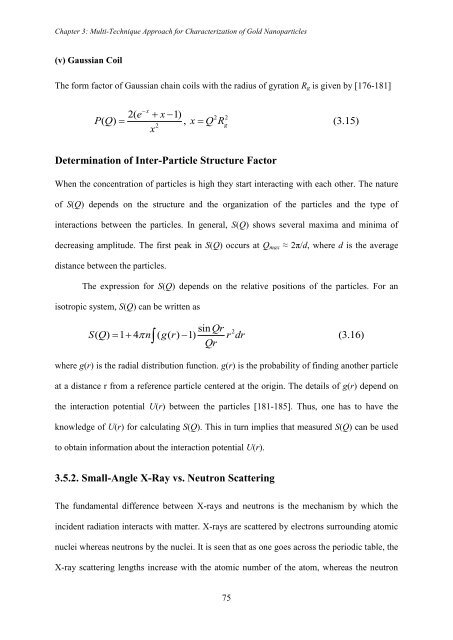PHYS01200704032 Debes Ray - Homi Bhabha National Institute
PHYS01200704032 Debes Ray - Homi Bhabha National Institute
PHYS01200704032 Debes Ray - Homi Bhabha National Institute
You also want an ePaper? Increase the reach of your titles
YUMPU automatically turns print PDFs into web optimized ePapers that Google loves.
Chapter 3: Multi-Technique Approach for Characterization of Gold Nanoparticles<br />
(v) Gaussian Coil<br />
The form factor of Gaussian chain coils with the radius of gyration R g is given by [176-181]<br />
2( e<br />
x1)<br />
P Q x Q R<br />
x<br />
x<br />
2 2<br />
( ) , <br />
(3.15)<br />
2<br />
g<br />
Determination of Inter-Particle Structure Factor<br />
When the concentration of particles is high they start interacting with each other. The nature<br />
of S(Q) depends on the structure and the organization of the particles and the type of<br />
interactions between the particles. In general, S(Q) shows several maxima and minima of<br />
decreasing amplitude. The first peak in S(Q) occurs at Q max ≈ 2π/d, where d is the average<br />
distance between the particles.<br />
The expression for S(Q) depends on the relative positions of the particles. For an<br />
isotropic system, S(Q) can be written as<br />
sin Qr<br />
S Q n<br />
g r r dr<br />
Qr<br />
2<br />
( ) 1<br />
4 ( ( ) 1) (3.16)<br />
where g(r) is the radial distribution function. g(r) is the probability of finding another particle<br />
at a distance r from a reference particle centered at the origin. The details of g(r) depend on<br />
the interaction potential U(r) between the particles [181-185]. Thus, one has to have the<br />
knowledge of U(r) for calculating S(Q). This in turn implies that measured S(Q) can be used<br />
to obtain information about the interaction potential U(r).<br />
3.5.2. Small-Angle X-<strong>Ray</strong> vs. Neutron Scattering<br />
The fundamental difference between X-rays and neutrons is the mechanism by which the<br />
incident radiation interacts with matter. X-rays are scattered by electrons surrounding atomic<br />
nuclei whereas neutrons by the nuclei. It is seen that as one goes across the periodic table, the<br />
X-ray scattering lengths increase with the atomic number of the atom, whereas the neutron<br />
75

















